One Million Faces.
Usually rainy London has been... usually rainy the past week, after being unusually not rainy the previous few months. However, tight t-shirt season is threatening to break in... the hillsides of flesh are on show and being a thoroughly cosmopolitan capital, the view is good lol.
With damp weather comes clothing, that having been washed in a fancy European front loader (that takes bloody hours to do what an Aussie top loader would do, admittedly a little more roughly, in half the time), goes dank n stale when it takes 3 whole days to dry.
Ive had to use the microwave to dry my socks twice now. 15 seconds on high with breaks in between to let the steam escape, repeated 8 times. Toasty!
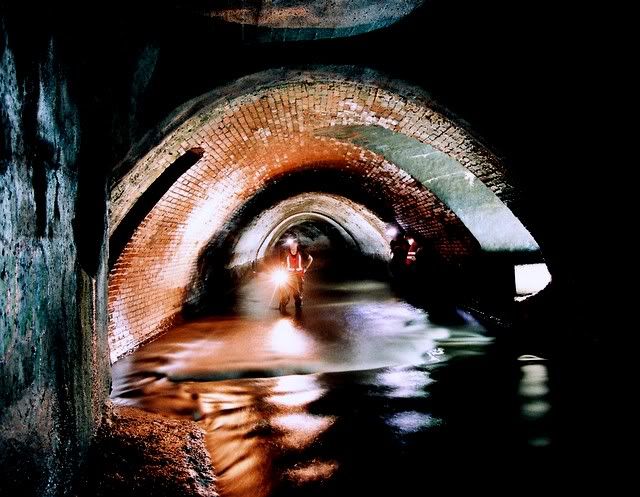
Moscow's best known lost river... Also known as the Neglinnaya River, its a 7km tributary of the Moscow River, that presently outfalls via two tunnels, one to the east of the Moscow Kremlin, the other to the west of it. Like London's River Fleet it was the largest and best known of the inner city rivers to be covered over, having previously formed a moat around one side of the Kremlin. It was canalised in 1792, its presence having hindered the development of the area due to its proneness for flooding. Unlike the River Fleet, it was quickly covered over in 1817 when it became heavily polluted, forming a masonry arch tunnel that still survives today, albeit abandoned.
Until 1887 when the city created a centralised sewage system, the Neglinka system acted as a sanitary refuse collector. These days it is almost entirely separated and as such only carries stream water and road run-off. In 1910 work started to replace the original tunnel, but the construction was cut short by the outbreak of WW2. The system was left incomplete with the inadequately small old section feeding into the larger new section.
Finally, in 1966, the old tunnel was disused and a newer concrete tunnel built onto the remnants of the still suitable 1910 tunnel. The rivers two tributary tunnels were enlarged and an overflow resulting in a secondary outfall was added.
My trip to Neglinka ... kinda started back in 2003 when, while perusing the internet, i found a website run by the Gugno Diggers. It was the first site i had ever seen online that documented Russian drainage. Running it through Babelfish i managed to extract the name of the largest tunnel, the one that always popped up, its name.... Neglinka.
Cut to 2008. Im in Moscow with Dsankt, Quantum X and Flame and by perfect good fortune, the hostel we'd booked is situated outside the long ornate boulevard garden that Neglinka tunnel runs beneath.
moscowhite and the_reverse met us at out hostel and as we changed, the skies, which had held a face of black gloom all afternoon, opened and deluged the area. It didnt look too good. But we headed out anyway, as the manhole shaft we were to use lead to both the drains older abandoned sections and a utility tunnel.
We popped a large grille in a traffic island, during rush hour, on one of the busiest intersections in the area, the driving rain aiding our deviance as its wetness pointed peoples faces to the pavement and away from us. Down we went, where we discovered first hand the wonderfully odd habit that Russian utility corporations have for leaving the lights on, even after work has long since been abandoned.
Arriving in an... incomplete shaft, we stepped through a hole in the wall and into a room, lit by tungsten bulbs and strewn with discarded construction debris. In the photo below, the tunnel to the right is the downstream section of Old Neglinka, the hole in the wall at the back leads to the shaft and a flooded cable tunnel and out of sight to the left is the upstream section of Old Neglinka.
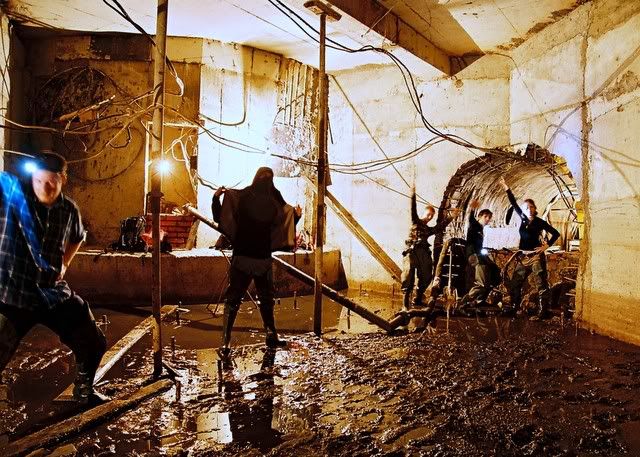
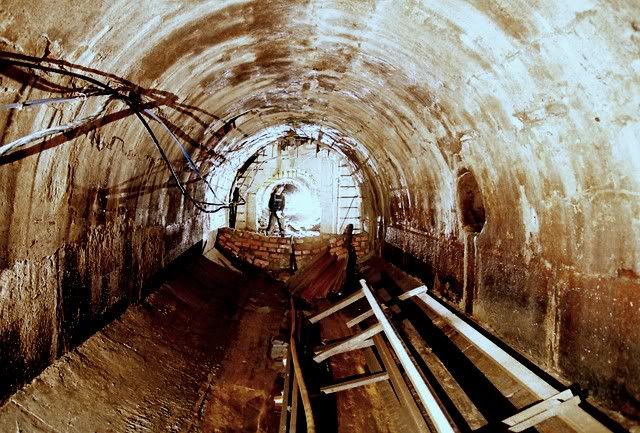
It was upstream that we headed, stepping over a mass of debris and old pipes being used to dam the steady drizzle from the old tunnel. Stepping into the murky water, we sloshed onwards through the 8ft high stone arch, its 192 year old natural façade long since covered with concrete. It wove back and forth quite a bit, and was interrupted by hodge-podge access chambers and weirs. Eventually the water gave way to endless shallow mud and the height dropped to barely 6'6ft. It was obvious why this smaller tunnel had been insufficient in size.
We didnt have to walk far before reaching the end of the line. Stepping out into a larger unconcreted section, rounding a bend saw us before a backfill earthmound.
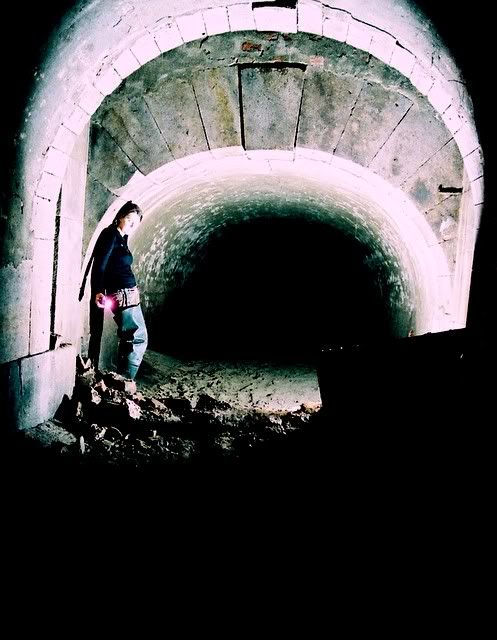
Walking back to our entry, we stopped for photo in the lit chamber, before continuing down the old Neglinka to the newer tunnel, in the hope that despite the rain, it might be traversable. We had to squeeze through a timber plank 'curtain' to get there, this mild obstacle forming the boundary of the abandoned works.
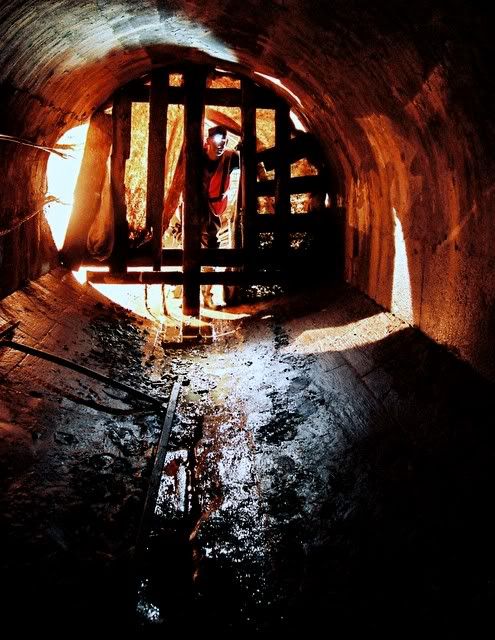
The junction between the Old Tunnel and the newer 1966 Neglinka main tunnel, i unfortunately forgot to photograph but here is a photo by paratozor of it, with the 1966 tunnel to the right, and the 1817 tunnel emptying into it from the left.
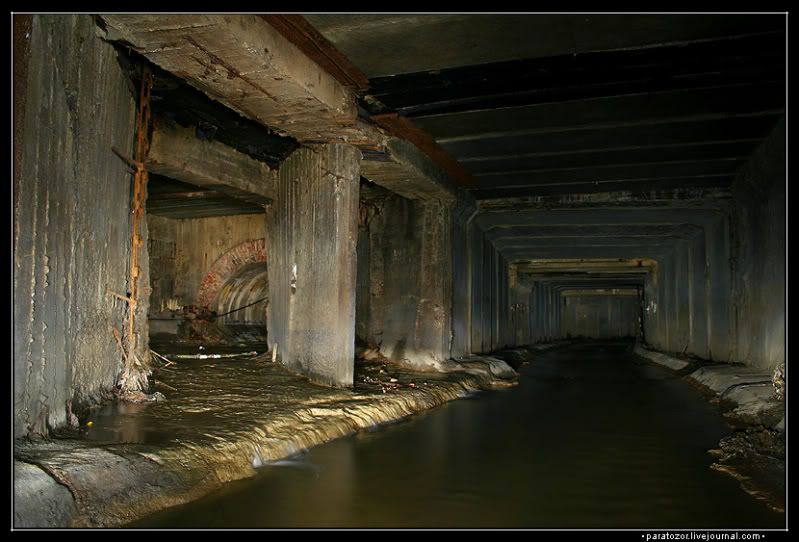
The main tunnel, a 12ft high by 15ft wide concrete box, was knee deep almost wall to wall. Fast flowing too. Anywhere else and we'dve been unable to traverse it. But its builders had cleverly incorporated crude sidewalks, that cleared the flow by mere inches and provided a 2ft wide passage alongside the torrent. It was slow going, but relaxing, and as we walked the flow slowly decreased. Rounding a bend, i finally saw the huge archway. The 1910 tunnel, a beautiful juggernaut of brick, 15ft tall and with even a bit of space for walking on the sides of its wide cross section.
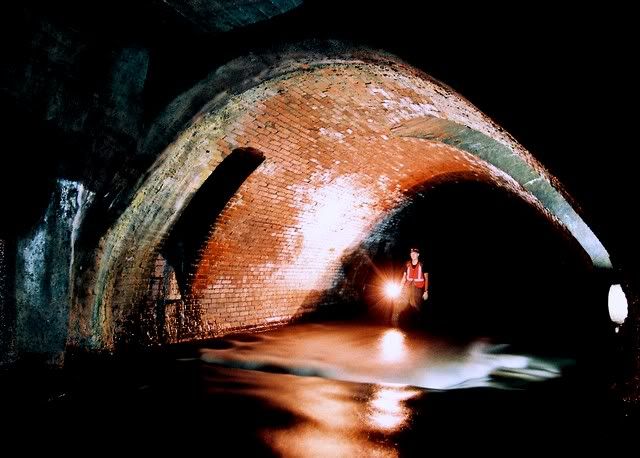

This section i knew wasnt particularly long, but its short length, the result of WW1, made it more special, making it a crown piece on this awesome shape changer of a drain. We rounded a variety of long sweeping bends before reaching the end of the archways tenure where the massive quantities of river water dumped into a 11ft diameter rcp, that was way to full and fast flowing to justify traversal.
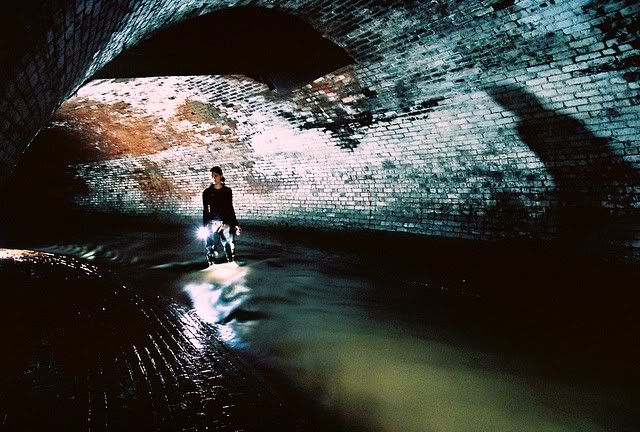
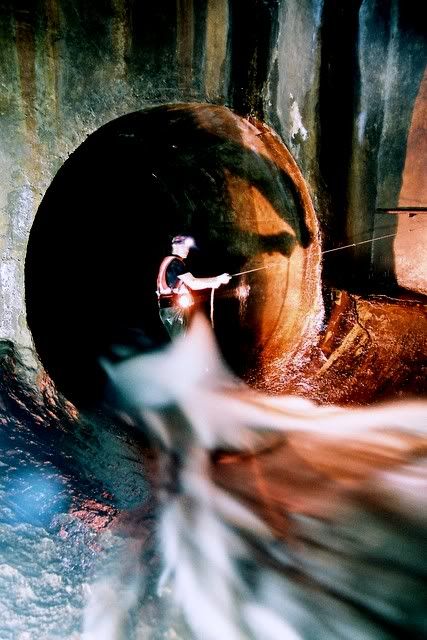
To the right was the elevated overflow, leading eventually to the secondary outfall. As we explored this a bit, Moscowhite popped a nearby lid and poking our heads out we found ourselves just a stones throw from Red Square, our heads sticking out in a parking spot near the Opera House.
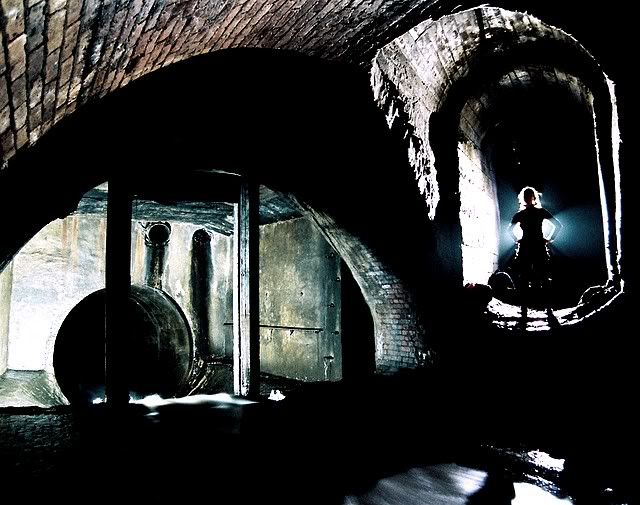
Not that im complaining, lol, but the problem with drain tourism is that you tend to skirt the extremities. Id have loved to walked down the near dry overflow, but had to settle for a 200m jog, before we all turned back.
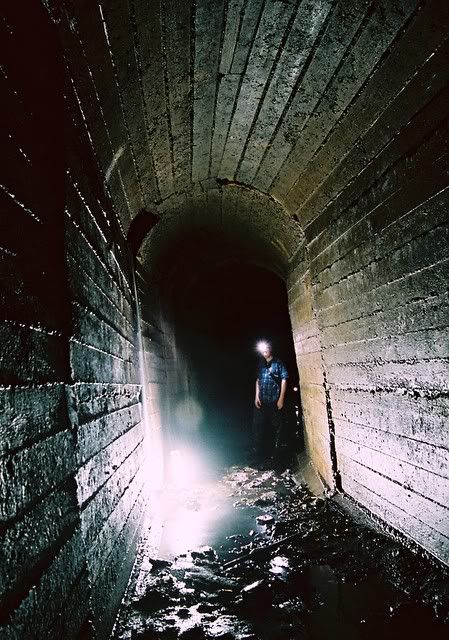
The flow of the main tunnel had decreased significantly, as we headed upstream, past the Old Neglinka, eventually reaching a junction, with a 10ft diameter rcp heading straight and a noisy 7ft rectangle off to the left.
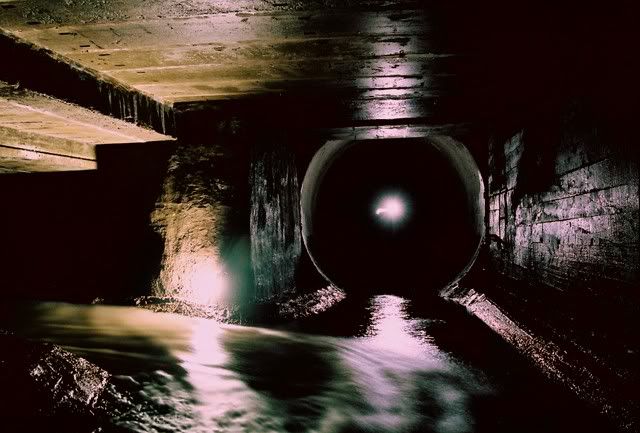
The noise was evidently coming from a short, but steep slide, barrelling down from a 90 degree bend above.
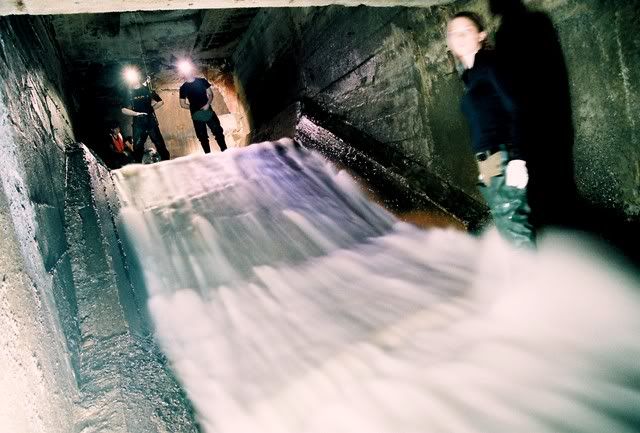
The 90 degree bend landed us back in brick territory, an 9ft archway that lead up under another boulevard garden. We passed a few small side tunnels before the arch split to another arch and a brick pipe, whereby, having been down there nearly four hours, we exited, popping our heads up to the sodium argon illuminated glare of a stern Russian statesman, immortalised in bronze.
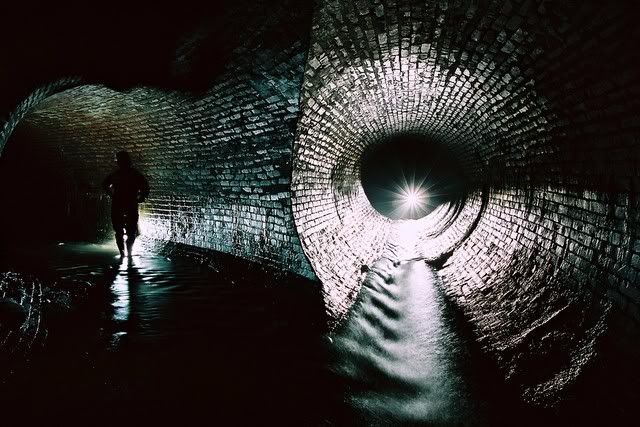
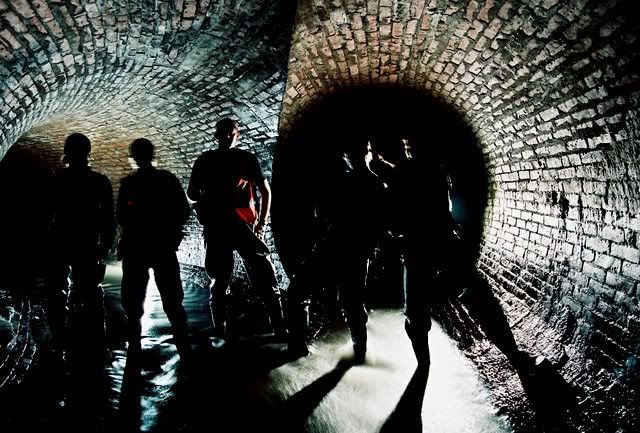
With damp weather comes clothing, that having been washed in a fancy European front loader (that takes bloody hours to do what an Aussie top loader would do, admittedly a little more roughly, in half the time), goes dank n stale when it takes 3 whole days to dry.
Ive had to use the microwave to dry my socks twice now. 15 seconds on high with breaks in between to let the steam escape, repeated 8 times. Toasty!

Moscow's best known lost river... Also known as the Neglinnaya River, its a 7km tributary of the Moscow River, that presently outfalls via two tunnels, one to the east of the Moscow Kremlin, the other to the west of it. Like London's River Fleet it was the largest and best known of the inner city rivers to be covered over, having previously formed a moat around one side of the Kremlin. It was canalised in 1792, its presence having hindered the development of the area due to its proneness for flooding. Unlike the River Fleet, it was quickly covered over in 1817 when it became heavily polluted, forming a masonry arch tunnel that still survives today, albeit abandoned.
Until 1887 when the city created a centralised sewage system, the Neglinka system acted as a sanitary refuse collector. These days it is almost entirely separated and as such only carries stream water and road run-off. In 1910 work started to replace the original tunnel, but the construction was cut short by the outbreak of WW2. The system was left incomplete with the inadequately small old section feeding into the larger new section.
Finally, in 1966, the old tunnel was disused and a newer concrete tunnel built onto the remnants of the still suitable 1910 tunnel. The rivers two tributary tunnels were enlarged and an overflow resulting in a secondary outfall was added.
My trip to Neglinka ... kinda started back in 2003 when, while perusing the internet, i found a website run by the Gugno Diggers. It was the first site i had ever seen online that documented Russian drainage. Running it through Babelfish i managed to extract the name of the largest tunnel, the one that always popped up, its name.... Neglinka.
Cut to 2008. Im in Moscow with Dsankt, Quantum X and Flame and by perfect good fortune, the hostel we'd booked is situated outside the long ornate boulevard garden that Neglinka tunnel runs beneath.
moscowhite and the_reverse met us at out hostel and as we changed, the skies, which had held a face of black gloom all afternoon, opened and deluged the area. It didnt look too good. But we headed out anyway, as the manhole shaft we were to use lead to both the drains older abandoned sections and a utility tunnel.
We popped a large grille in a traffic island, during rush hour, on one of the busiest intersections in the area, the driving rain aiding our deviance as its wetness pointed peoples faces to the pavement and away from us. Down we went, where we discovered first hand the wonderfully odd habit that Russian utility corporations have for leaving the lights on, even after work has long since been abandoned.
Arriving in an... incomplete shaft, we stepped through a hole in the wall and into a room, lit by tungsten bulbs and strewn with discarded construction debris. In the photo below, the tunnel to the right is the downstream section of Old Neglinka, the hole in the wall at the back leads to the shaft and a flooded cable tunnel and out of sight to the left is the upstream section of Old Neglinka.


It was upstream that we headed, stepping over a mass of debris and old pipes being used to dam the steady drizzle from the old tunnel. Stepping into the murky water, we sloshed onwards through the 8ft high stone arch, its 192 year old natural façade long since covered with concrete. It wove back and forth quite a bit, and was interrupted by hodge-podge access chambers and weirs. Eventually the water gave way to endless shallow mud and the height dropped to barely 6'6ft. It was obvious why this smaller tunnel had been insufficient in size.
We didnt have to walk far before reaching the end of the line. Stepping out into a larger unconcreted section, rounding a bend saw us before a backfill earthmound.

Walking back to our entry, we stopped for photo in the lit chamber, before continuing down the old Neglinka to the newer tunnel, in the hope that despite the rain, it might be traversable. We had to squeeze through a timber plank 'curtain' to get there, this mild obstacle forming the boundary of the abandoned works.

The junction between the Old Tunnel and the newer 1966 Neglinka main tunnel, i unfortunately forgot to photograph but here is a photo by paratozor of it, with the 1966 tunnel to the right, and the 1817 tunnel emptying into it from the left.

The main tunnel, a 12ft high by 15ft wide concrete box, was knee deep almost wall to wall. Fast flowing too. Anywhere else and we'dve been unable to traverse it. But its builders had cleverly incorporated crude sidewalks, that cleared the flow by mere inches and provided a 2ft wide passage alongside the torrent. It was slow going, but relaxing, and as we walked the flow slowly decreased. Rounding a bend, i finally saw the huge archway. The 1910 tunnel, a beautiful juggernaut of brick, 15ft tall and with even a bit of space for walking on the sides of its wide cross section.


This section i knew wasnt particularly long, but its short length, the result of WW1, made it more special, making it a crown piece on this awesome shape changer of a drain. We rounded a variety of long sweeping bends before reaching the end of the archways tenure where the massive quantities of river water dumped into a 11ft diameter rcp, that was way to full and fast flowing to justify traversal.


To the right was the elevated overflow, leading eventually to the secondary outfall. As we explored this a bit, Moscowhite popped a nearby lid and poking our heads out we found ourselves just a stones throw from Red Square, our heads sticking out in a parking spot near the Opera House.

Not that im complaining, lol, but the problem with drain tourism is that you tend to skirt the extremities. Id have loved to walked down the near dry overflow, but had to settle for a 200m jog, before we all turned back.

The flow of the main tunnel had decreased significantly, as we headed upstream, past the Old Neglinka, eventually reaching a junction, with a 10ft diameter rcp heading straight and a noisy 7ft rectangle off to the left.

The noise was evidently coming from a short, but steep slide, barrelling down from a 90 degree bend above.

The 90 degree bend landed us back in brick territory, an 9ft archway that lead up under another boulevard garden. We passed a few small side tunnels before the arch split to another arch and a brick pipe, whereby, having been down there nearly four hours, we exited, popping our heads up to the sodium argon illuminated glare of a stern Russian statesman, immortalised in bronze.

